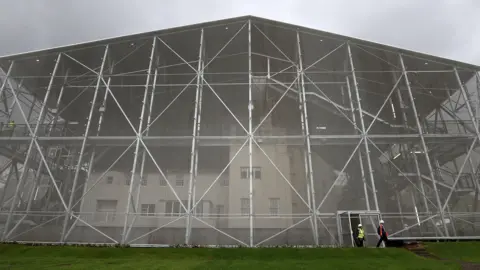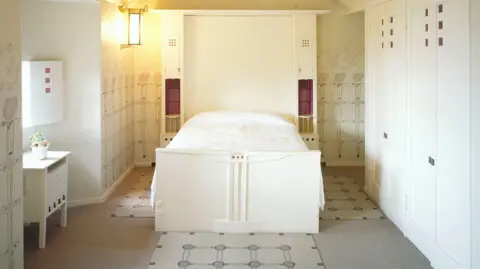Mackintosh Hill House project at 'exciting' stage
 PA
PAOrganisers of a project to dry out the Hill House in Helensburgh say their work has reached a "really exciting" stage.
The property, designed by Charles Rennie Mackintosh, has been threatened by the effects of water penetration.
A giant steel box was built around the property in 2019 to protect its saturated walls from further damage from the elements and enable it to gradually dry out as the first stage in a long-term conservation programme.
The project's director Elizabeth Davidson said that the relative humidity in the house reached "acceptable conservation standards" due to the ongoing work.
The Hill House has been badly affected by the driving rain of Scotland's west coast since its construction in 1904 , which meant both the structure of the house and the bespoke interior decoration were damaged.
Rennie Mackintosh had envisioned it as "a home for the future" and used experimental building material - which has allowed water to soak into the building.
The National Trust for Scotland (NTS), which cares for the property, said samples taken from the outside of the house in late 2023 showed the structure is drying out as planned.
 PA
PAConservation experts will now take samples from the interior of the building to build up understanding of the water damage and how much this has been reversed by the protection of the box.
Project director Elizabeth Davidson said they were at "a really exciting stage" in their work.
"The box has been doing its dual job of preventing further water from impacting on the building, and also allowing the structure, which in some places was very wet indeed, to dry out gradually," she said.
"We've been closely monitoring this process and this sampling helps us gain more insight into how the building is responding to the drying process.
"Relative humidity in the house is now down to acceptable conservation standards - a remarkable achievement given the very visible areas of rain penetration previously through microcracking in the structure," she added.
 PA
PAAn appeal for funding to support the project secured over £1m in donations.
Future plans involve taking a series of samples from key internal points in the house badly affected by water ingress, such as the living room and dining room.
Conservators will then use the information they gain to inform future decisions about how best to repair and restore the building.
The house will be closed to visitors while this work is under way, although the walkways, café, shop and garden will remain open.
The complete removal of the external concrete render on the building is planned for late 2024.
